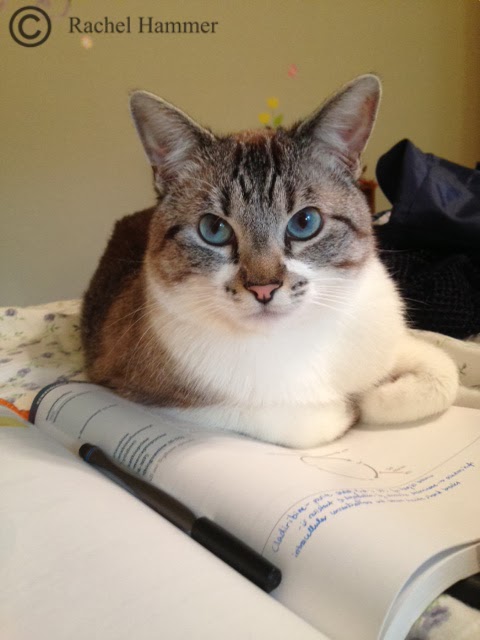So is it possible to take professional-quality photographs with your smartphone?
Well, yes...if you choose your subjects and your lighting carefully. As my facebook feed is constantly flooded with pictures of people's pets, I figured pet photography was a good starting point.
How to Make the Most of your Smartphone Camera
I mentioned earlier that you can create excellent photographs with your smartphone, if you choose the right scene. My experience here is with the iPhone camera, which does not let you manually adjust camera settings.
Here are a few general smartphone pointers:
1. Avoid contrasty scenes
Scenes with a large difference between the darkest and the brightest point in the picture will turn out over- or -underexposed on many smartphones. Choose a situation with fairly even light to get the best results.
 |
| The bright white blown-out computer screen is very distracting in this high contrast photo. |
2. Read the manual
This is the first thing you should do with ANY camera. Seriously, the features won't help you if you don't know how to use them.
3. Work with easily available subjects
By this I mean, your subject should fill the frame. However, most smart phones have very limited zoom capabilities. The "digital zoom" most are equipped with usually just results in very low image quality. Instead of resorting to this, your phone's camera is best used for subjects that are very large (ie, landscapes) or that will let you get very close to them (ie, your dog).
All right, so let's say you, like so many others, have found your "available" subject in the form of your adorable, fat puppy. Now what do you do?
Well, the basics of pet photography apply regardless of what kind of camera you are using.
1. Shoot at eye level
While the top of your kitten's head is cute, his face is probably cuter. We have a tendency to "shoot down" at animals because they are shorter than we are. This results in photos of backs and ears from funny perspectives. That's generally not what you want. When you're photographing an animal like this, your camera should generally be at the eye level of your subject.
 |
| Top-down, we can't even really see what he looks like |
 |
| This picture was taken at the same time as the one above, but was taken at eye level. |
2. Think about the composition
One of the biggest advantages of photographing your pet versus a wild animal is that he will generally sit still for you for long periods of time. This should give you ample opportunity to think about the composition of your photograph. Are you following the rule of thirds? Is your underwear unobtrusively sitting in the background of the picture? Is your lighting ok? These are questions to consider before you click the "shutter" button.
 |
| This picture is pretty cute, but there is a lot of distracting material in the background that takes away from the subject. |
 |
| Here, the background is clean, allowing us to focus all of our attention on the subject. |
3. Try shooting with natural lighting
Many times when we are with our pets and our phones, we are indoors. This results in photographs that may be dark, yellow (from incandescent light), or "flat" (from the automatic flash). Try to get your subject in front of a window for a little taste of soft, natural lighting inside.
4. Turn off your flash
On a smart phone, the flash feature generally serves to hit your subject right in the face with a blinding burst of light, creating red eye, casting weird shadows, and lending a characteristic "flatness" to the photo. It also tends to startle animals or make them squint. It's no good. Just turn it off.
 |
| The flash causes apparent "flattening" of his head against his body, red eye, and squinting. No wonder he looks so mad. |
5. Try to capture a mix of interesting behavior and portraits
Here's my final tip for you. A lot of us rush to grab our cameras when our pets are "doing something cute" -- and that's good. One of the keys to pet photography is variety. You don't really need 50 pictures of your overweight cat sleeping on the couch. At the same time, you don't need to spam your grandmother's inbox with photos of him sitting on your head. Or whatever. Try to illustrate elements of your pet's personality in your photos. In the end, your pictures should describe him (or her) as an individual, and not merely be a record of his existence.
Would you rather be taking pictures of flowers? Head over here for some great flower photography tips!
Want to be up to date on my latest tips? Click here to follow me on Tumblr and here to follow me on Bloglovin'. You can also use the nifty sidebar to subscribe via RSS feed or email!


No comments:
Post a Comment